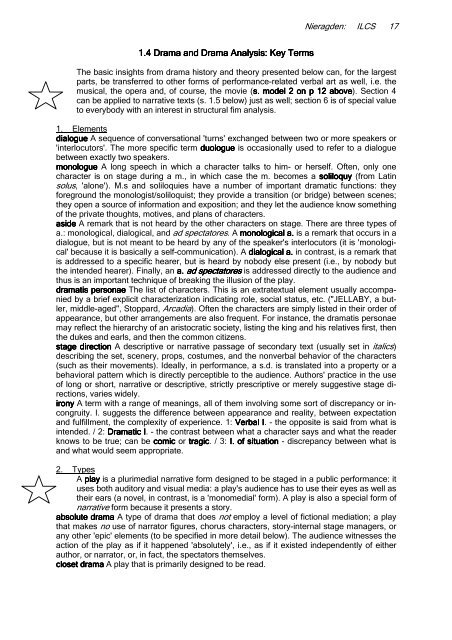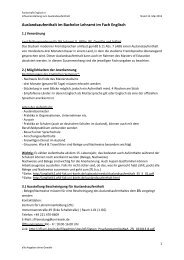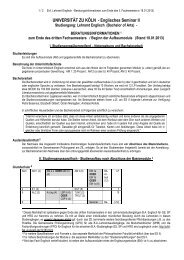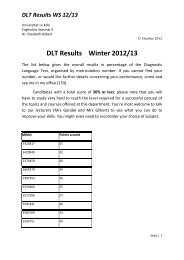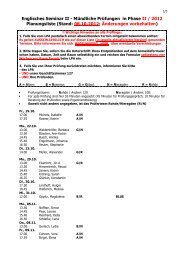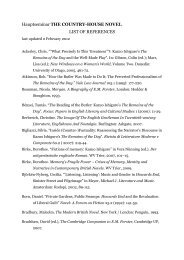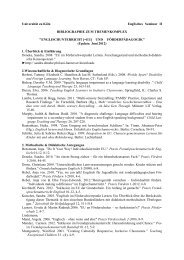STUDENT SCRIPT - Englisches Seminar II - Universität zu Köln
STUDENT SCRIPT - Englisches Seminar II - Universität zu Köln
STUDENT SCRIPT - Englisches Seminar II - Universität zu Köln
You also want an ePaper? Increase the reach of your titles
YUMPU automatically turns print PDFs into web optimized ePapers that Google loves.
1. 1.4 1. DDrama<br />
D Drama<br />
rama and and Drama Drama Analysis Analysis: Analysis : Key Key Terms<br />
Terms<br />
Nieragden: ILCS 17<br />
The basic insights from drama history and theory presented below can, for the largest<br />
parts, be transferred to other forms of performance-related verbal art as well, i.e. the<br />
musical, the opera and, of course, the movie (s. s. model 2 2 on on on p p 12 above above). above Section 4<br />
can be applied to narrative texts (s. 1.5 below) just as well; section 6 is of special value<br />
to everybody with an interest in structural fim analysis.<br />
1. Elements<br />
dialogue dialogue dialogue A sequence of conversational 'turns' exchanged between two or more speakers or<br />
'interlocutors'. The more specific term duologue is occasionally used to refer to a dialogue<br />
between exactly two speakers.<br />
monologue monologue A long speech in which a character talks to him- or herself. Often, only one<br />
character is on stage during a m., in which case the m. becomes a soliloquy (from Latin<br />
solus, 'alone'). M.s and soliloquies have a number of important dramatic functions: they<br />
foreground the monologist/soliloquist; they provide a transition (or bridge) between scenes;<br />
they open a source of information and exposition; and they let the audience know something<br />
of the private thoughts, motives, and plans of characters.<br />
aside aside A remark that is not heard by the other characters on stage. There are three types of<br />
a.: monological, dialogical, and ad spectatores. A monological a. is a remark that occurs in a<br />
dialogue, but is not meant to be heard by any of the speaker's interlocutors (it is 'monological'<br />
because it is basically a self-communication). A dia dialogical dia<br />
logical logical a. a. in contrast, is a remark that<br />
is addressed to a specific hearer, but is heard by nobody else present (i.e., by nobody but<br />
the intended hearer). Finally, an a. a. ad ad ad ad spectatores<br />
spectatores spectatores<br />
spectatores is addressed directly to the audience and<br />
thus is an important technique of breaking the illusion of the play.<br />
dramatis dramatis personae personae The list of characters. This is an extratextual element usually accompanied<br />
by a brief explicit characterization indicating role, social status, etc. ("JELLABY, a butler,<br />
middle-aged", Stoppard, Arcadia). Often the characters are simply listed in their order of<br />
appearance, but other arrangements are also frequent. For instance, the dramatis personae<br />
may reflect the hierarchy of an aristocratic society, listing the king and his relatives first, then<br />
the dukes and earls, and then the common citizens.<br />
stage stage direction direction A descriptive or narrative passage of secondary text (usually set in italics)<br />
describing the set, scenery, props, costumes, and the nonverbal behavior of the characters<br />
(such as their movements). Ideally, in performance, a s.d. is translated into a property or a<br />
behavioral pattern which is directly perceptible to the audience. Authors' practice in the use<br />
of long or short, narrative or descriptive, strictly prescriptive or merely suggestive stage directions,<br />
varies widely.<br />
irony irony A term with a range of meanings, all of them involving some sort of discrepancy or incongruity.<br />
I. suggests the difference between appearance and reality, between expectation<br />
and fulfillment, the complexity of experience. 1: Verbal <strong>II</strong>.<br />
I<br />
- the opposite is said from what is<br />
intended. / 2: Dramatic <strong>II</strong>.<br />
I<br />
- the contrast between what a character says and what the reader<br />
knows to be true; can be comi comic comi<br />
or tragic tragic. tragic<br />
/ 3: I. of situation - discrepancy between what is<br />
and what would seem appropriate.<br />
2. Types<br />
A play is a plurimedial narrative form designed to be staged in a public performance: it<br />
uses both auditory and visual media: a play's audience has to use their eyes as well as<br />
their ears (a novel, in contrast, is a 'monomedial' form). A play is also a special form of<br />
narrative form because it presents a story.<br />
absolute absolute drama drama A type of drama that does not employ a level of fictional mediation; a play<br />
that makes no use of narrator figures, chorus characters, story-internal stage managers, or<br />
any other 'epic' elements (to be specified in more detail below). The audience witnesses the<br />
action of the play as if it happened 'absolutely', i.e., as if it existed independently of either<br />
author, or narrator, or, in fact, the spectators themselves.<br />
closet closet closet drama drama drama A play that is primarily designed to be read.


